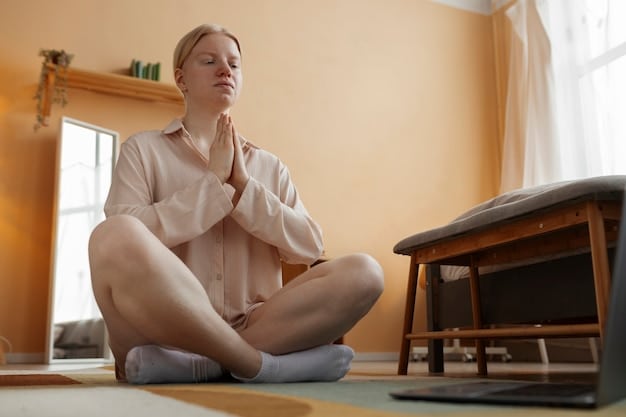Managing Test Anxiety: Proven Strategies for US Students

Managing test anxiety involves employing various strategies such as practicing relaxation techniques, improving study habits, and seeking professional support to reduce stress and enhance performance for students in the US.
Test anxiety can significantly impact academic performance, but it doesn’t have to. Managing test anxiety effectively involves implementing proven strategies tailored for students here in the US to help them reduce stress and perform at their best.
Understanding Test Anxiety
Test anxiety is more than just a case of nerves; it’s a psychological condition that can seriously hinder a student’s ability to perform well on exams. Recognizing the signs and understanding the underlying causes are crucial first steps in managing this common issue.
What is Test Anxiety?
Test anxiety is a form of performance anxiety that occurs in evaluative situations. It can manifest through both physical symptoms and cognitive impairments, making it difficult for students to focus and recall information.
Common Symptoms of Test Anxiety
The symptoms can vary from person to person, but some common indicators include increased heart rate, sweating, trembling, nausea, and a feeling of panic. Cognitively, students may experience racing thoughts, difficulty concentrating, and memory blocks.
- Increased heart rate and rapid breathing
- Excessive sweating and trembling
- Feelings of dread, fear, or panic
- Difficulty concentrating and focusing on the test
These symptoms can create a negative feedback loop, where anxiety leads to poor performance, which in turn increases anxiety in future test situations.

Understanding the nature of test anxiety and its symptoms is a pivotal step towards adopting effective management strategies. By acknowledging and addressing these issues, students can begin to reclaim control over their academic performance and overall well-being.
Effective Study Habits to Reduce Anxiety
One of the best defenses against test anxiety is preparation. Developing effective study habits not only improves your understanding of the material but also boosts your confidence, which can significantly reduce anxiety during exams.
Create a Study Schedule
A well-structured study schedule ensures that you cover all the necessary material without feeling overwhelmed. Break down your study sessions into manageable chunks and allocate specific times for each subject.
Active Learning Techniques
Instead of passively reading through textbooks, engage in active learning techniques like summarizing, teaching the material to someone else, or creating flashcards. These methods help reinforce your understanding and improve retention.
- Summarize each chapter or section in your own words
- Teach the material to a friend or study group
- Create flashcards for key terms and concepts
- Practice with past exams and quizzes
By actively engaging with the material, you not only enhance your understanding but also build confidence in your ability to recall and apply that knowledge during the test.
Establishing effective study habits is a cornerstone of managing test anxiety. By taking a proactive approach to learning and preparation, students can feel more confident and less anxious when facing exams.
Relaxation Techniques for Immediate Relief
Relaxation techniques can be invaluable tools for managing test anxiety, both in the lead-up to exams and during the test itself. These techniques help to calm the mind and body, reducing the physical and mental symptoms of anxiety.
Deep Breathing Exercises
Deep breathing exercises involve taking slow, deep breaths to activate the body’s relaxation response. This can help to lower your heart rate, reduce muscle tension, and calm your nerves.
Progressive Muscle Relaxation
Progressive muscle relaxation involves tensing and releasing different muscle groups in your body. This technique can help to reduce overall muscle tension and promote a sense of calm.

- Find a quiet place to sit or lie down
- Focus on your breath, inhaling deeply and exhaling slowly
- Tense and release various muscle groups, starting with your toes and working your way up to your head
- Visualize a calm and peaceful scene
Implementing relaxation techniques is an effective way to manage test anxiety, providing immediate relief and promoting a sense of calm and control. These practices can be incorporated into your daily routine, making them readily available when needed most.
The Role of Positive Self-Talk
How you speak to yourself can significantly influence your anxiety levels. Positive self-talk involves replacing negative thoughts with positive, encouraging ones, helping to build confidence and reduce fear.
Identify Negative Thought Patterns
Start by identifying the negative thoughts that arise when you think about tests. These might include statements like “I’m going to fail” or “I’m not smart enough.” Recognizing these patterns is the first step in changing them.
Replace Negative Thoughts with Positive Affirmations
Once you’ve identified your negative thoughts, challenge them and replace them with positive affirmations. For example, instead of thinking “I’m going to fail,” try “I’ve studied hard, and I’m prepared to do my best.”
By consciously choosing to focus on positive thoughts, you can shift your mindset and reduce the impact of test anxiety. This proactive approach helps build resilience and fosters a more confident and optimistic outlook.
Seeking Professional Help
Sometimes, test anxiety can be overwhelming, and professional help may be necessary. Therapists and counselors can provide valuable support and guidance, offering strategies and techniques to manage anxiety effectively.
Cognitive Behavioral Therapy (CBT)
CBT is a type of therapy that focuses on identifying and changing negative thought patterns and behaviors. It can be particularly effective for managing test anxiety by helping students develop coping strategies and challenge irrational fears.
Counseling and Support Groups
Counseling provides a safe space to explore your feelings and concerns about tests. Support groups offer an opportunity to connect with other students who are experiencing similar challenges, providing a sense of community and shared understanding.
Seeking professional help is a courageous step towards managing test anxiety effectively. Therapists and counselors can provide personalized support and evidence-based strategies to help students overcome their fears and improve their academic performance.
Creating a Supportive Environment
A supportive environment can play a significant role in reducing test anxiety. Surrounding yourself with understanding friends, family, and educators can provide emotional support and encouragement, making you feel more confident and less alone.
Communicate with Your Teachers
Talk to your teachers about your test anxiety. They may be able to offer accommodations or support, such as extended time or a quiet testing environment. Open communication can also help them understand your challenges and provide targeted assistance.
Build a Support Network
Connect with friends and classmates who understand what you’re going through. Sharing your experiences and coping strategies can create a sense of camaraderie and mutual support. Consider forming a study group or joining a peer support program.
Conclusion
Managing test anxiety is a multifaceted process that requires a combination of effective study habits, relaxation techniques, positive self-talk, professional support, and a supportive environment. By implementing these strategies, students in the US can reduce their anxiety levels and perform to their full potential on exams.
| Key Point | Brief Description |
|---|---|
| 😌 Relaxation Techniques | Use deep breathing and muscle relaxation to calm nerves. |
| 📚 Effective Study Habits | Create a schedule and use active learning to boost confidence. |
| 💪 Positive Self-Talk | Replace negative thoughts with positive affirmations. |
| 🤝 Professional Help | Consider CBT or counseling for personalized support. |
Frequently Asked Questions
▼
Test anxiety can stem from various sources, including fear of failure, past negative experiences, high expectations, and poor preparation. Identifying the root cause is key to addressing it effectively.
▼
Deep breathing helps activate the body’s relaxation response by slowing down the heart rate and reducing muscle tension. This can calm the mind and alleviate physical symptoms of anxiety during tests.
▼
CBT is a type of therapy that helps identify and change negative thought patterns and behaviors. It equips students with coping strategies to manage anxiety and challenge irrational fears related to testing.
▼
Communicating with teachers can lead to accommodations like extended time or a quieter testing environment. It also helps teachers understand your challenges and provide specific assistance to help you succeed.
▼
Connecting with peers who understand your struggles creates a sense of community and mutual support. Sharing experiences and coping strategies can reduce feelings of isolation and boost confidence.
Conclusion
By understanding the causes of test anxiety and implementing these proven strategies, students can significantly reduce their stress and improve their performance on exams. Creating a supportive environment and seeking professional help when needed are also crucial steps in managing test anxiety effectively.





